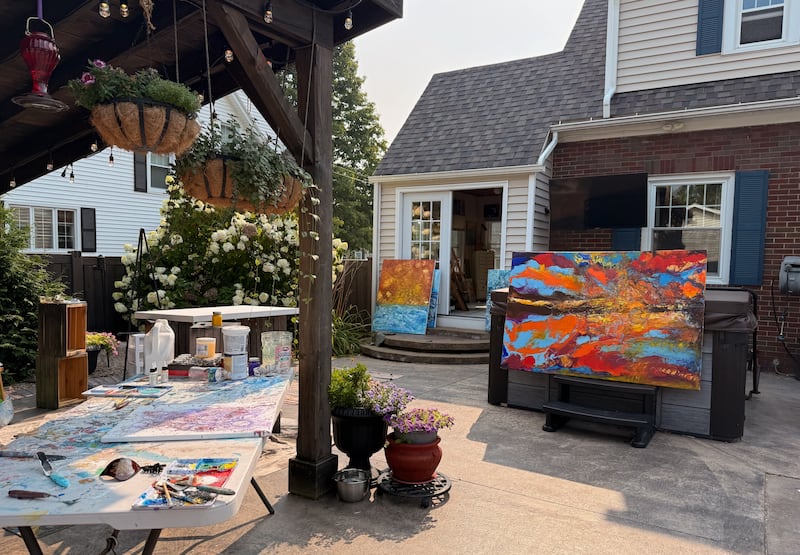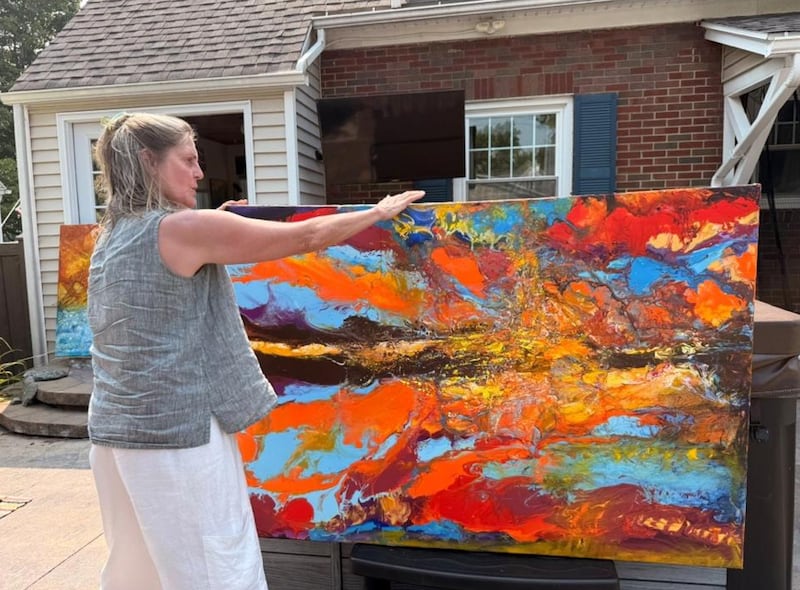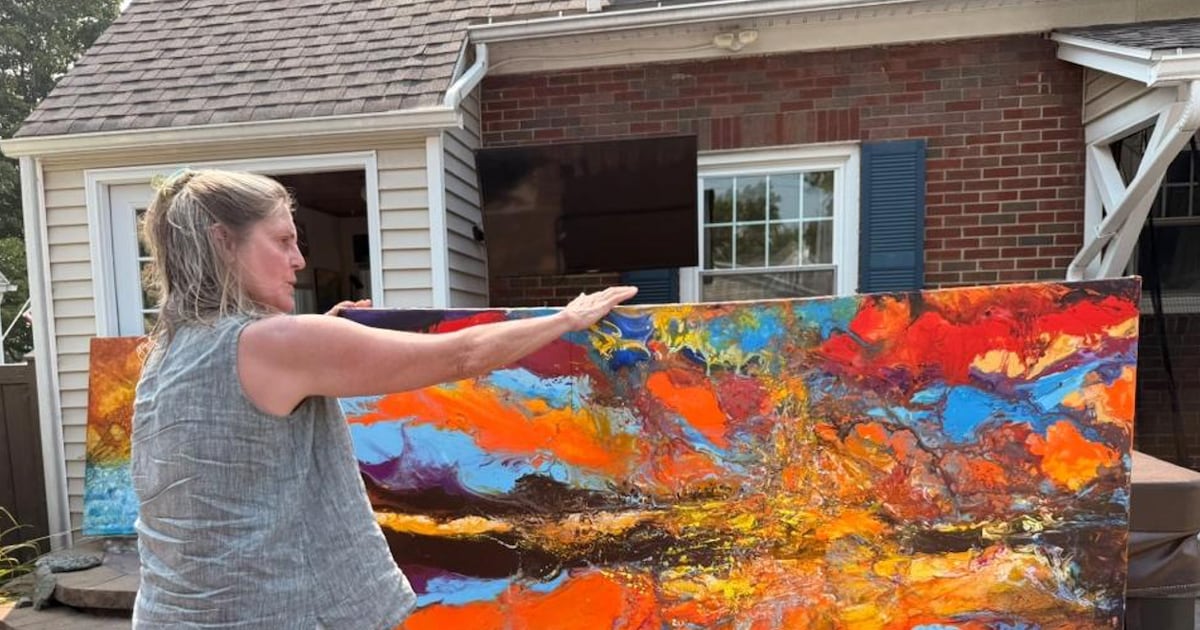 Artist JoAnne Sharman’s outdoor painting table and some of her recent works in front of her studio. (Zora Ma/Zora Ma)
Artist JoAnne Sharman’s outdoor painting table and some of her recent works in front of her studio. (Zora Ma/Zora Ma)
JoAnne Sharman had just set up her tent with paintings at the Keuka Arts Festival in Penn Yan, New York, when a woman glanced at her diptych, a two-piece painting. Sharman painted coral on it to make people feel as if they are looking down at the sea.
“Let me think about it,” the woman said. “Are you here tomorrow?”
“Don’t let it be the painting you almost bought,” Sharman said. “Be happy, spend the money, and you will always love it.”
And the woman bought that art for her office.
Sharman said she sells her art by overcoming objections, a sales skill she used to teach others when she was a store manager at the Corning Museum of Glass.
It means not taking “no” for an answer too quickly, and being confident in one’s artwork and talking with customers to make them feel comfortable asking questions.
“There’s as much sales skill needed as art skills,” she said.
Sharman became a full-time paint-based artist in December 2024 after retiring from the Corning Museum of Glass. Turning 60, Sharman said she is not a “sitter,” and now she sometimes spends an entire day painting in her Auburn, New York studio.
 Artist JoAnne Sharman shows one of her pouring acrylic paintings in her house in Auburn, New York, on Monday, August 4, 2025. Sharman became a full-time artist in December 2024 after retirement. (Photo by Zora Ma) (Zora Ma/Zora Ma)
Artist JoAnne Sharman shows one of her pouring acrylic paintings in her house in Auburn, New York, on Monday, August 4, 2025. Sharman became a full-time artist in December 2024 after retirement. (Photo by Zora Ma) (Zora Ma/Zora Ma)
Sharman has over 35 years of experience in high-end commission sales, including jewelry, furniture, interior design and the glass museum.
As a store manager at the museum, Sharman said she gained a solid understanding of glass art by watching demonstrations and taking classes in glassblowing.
“In any form, it’s fluid,” she said. “You have to turn it and spin it and manipulate it because it’s like working with honey.”
The fluid nature of glass inspired Sharman to start pouring acrylic paintings and build a studio to express her passion for fluid art.
Sharman pours colors onto a flat canvas, allows them to move around, and then manipulates the colors in layers.
“I love the spontaneity of it,” she said. “Let the paint dictate what comes next.”
Terri Wise, a close friend of the artist, said retiring helped Sharman to flourish in her work.
Wise said she remembered in the ‘90s, Sharman would go to flea markets to find old furniture, paint it, and give it new life. Sharman talked with Wise about many ideas for her artwork.
“The universe heard her calling, so it gave it back to her so she could be an artist,” Wise said.
Sharman is a creative person in the arts and in business, Wise said. She said when she worked for Sharman during the Christmas season at Littman Jewelers, Sharman once set up a wedding venue in the store to attract customers to buy wedding jewelry and engagement rings.
“She would always create fun atmospheres to bring in the people,” Wise said.
Sharman said she planned to use a bubble machine at the art shows in Florida last winter to match her bubble-themed paintings, but the paintings didn’t sell well because they were too small. So, she went back home and rearranged the work for the rest of the shows.
“And man, we got back, and we hit the West Coast and just did very well,” she said.
Steve Donigan, Sharman’s boyfriend, said he helped with the logistics when they traveled to Florida for Sharman’s art shows. “I’m her laborer,” he said.
Sharman said people really connect when they watch her paint on-site.
People asked questions while she painted, and she involved them in a whole conversation about when to deliver and where to place the painting in their homes by utilizing her interior design expertise, according to Donigan.
“I think she builds relationships with people that way,” he said. “The shows are what sells them.”
When Sharman sells her artwork, she often applies the sales strategies she used to teach people.
Sharman decided to implement a new return policy to overcome objections. If someone hesitated, she would say, “Nope, take it home. I’ll even bring it to you. See how it looks in the room. And if you don’t like it, bring it back to me tomorrow.”
“So, I think that I have to go back to being a student also, you know, and the teacher listening to my own lessons,” Sharman said.
There is a profound gap between people attending the art shows and those buying the art, said Sharman. She thinks artists don’t make enough money, so many can’t stay long in the industry, and she hopes other artists can learn the sales side of art and develop basic sales skills.
While she could convince people to buy her art, she could not convince them to love it, Sharman said. When her work sells, Sharman feels a sense of validation.
“When you know your work has a home that someone has bought and will enjoy themselves,” she said. “It’s just a cool feeling.”
More information about JoAnne Sharman’s studio and her artwork can be found at the website of her label, Lady Loo Art at ladylooart.com/about.

